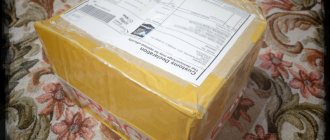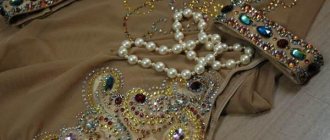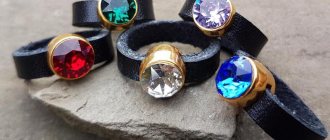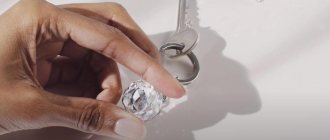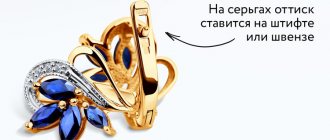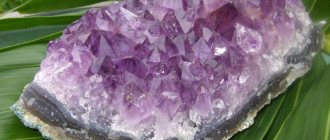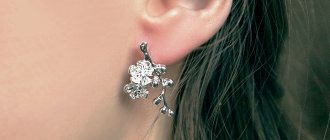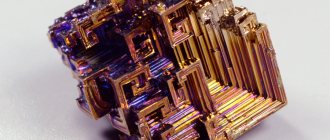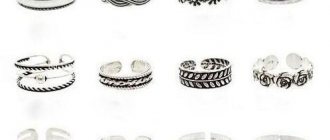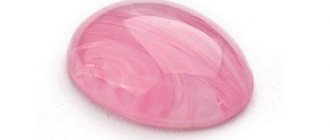There is a whole category of inserts in jewelry that do not fall under the usual classifications of stones: precious, organic, semi-precious, ornamental... These are artificial stones that have no analogues in the world of natural stones. Typical examples of such artificially created beauty are shining cubic zirconias , as well as various rhinestones (crystal), which, according to established habit, we usually call “crystals”.
Let us remind you: a huge number of artificial stones are now being produced in the world, which, in terms of chemical composition and physical properties, are complete analogues of their natural namesakes. For example, synthetic (grown) amethysts, topazes or opals. We discuss the technique of creating these stones, as well as the ethical aspects of their use in jewelry, in the “Synthetic Stones” section. These stones are taken into account in our classification where their natural analogues are taken into account.
And in this article we are talking about elements that have no natural analogues , and therefore are considered separately - outside of classification.
How can you tell a diamond from a fake?
The simplest, but slightly barbaric way to distinguish a diamond from any other stone is to run the crystal across the glass. A real hard diamond will leave a scratch, but most softer stones (except topaz) cannot boast of this.
Interesting materials:
How to reset settings on ASUS? How to reset settings on LG home theater? How to reset settings on iPhone? How to reset settings on LG K 10? How to reset settings on Microsoft 640? How to reset settings on Nokia if you forgot your password? How to reset a Lenovo tablet to factory settings? How to reset settings on Samsung if you forgot your password? How to reset a Tomahawk 9010 alarm system? How to reset settings on an Indesit washing machine?
cubic zirconia
Cubic zirconia is an artificially created imitation of a diamond, and it was grown in Russia - in the 60s of the last century. Despite the romantic name, the origin of the name of this stone is quite prosaic. This is just an abbreviation for the name of its “progenitor” - the FIAN Institute ( Physical Institute named after A.N. USSR).
Cubic zirconia is cubic zirconium oxide, but it should not be confused with the natural mineral zircon - these are different things. Created for industrial use, this crystal quickly captivated jewelers with its resemblance to a diamond. From that moment on, the stone, also due to the low cost of its synthesis, began to be widely used as inserts in jewelry. It is worth noting that the similarity between cubic zirconia and a diamond is quite superficial, and not only a specialist, but also an “advanced user” can easily distinguish one from the other. It is believed that after a few years, jewelry with cubic zirconia partially loses its appearance due to scratches and a decrease in the shine of the stone. This also distinguishes this cubic zirconia from a diamond, which is much more durable.
What gives cubic zirconia a special value for jewelry is their remarkable ability to be painted in different colors. For example, adding cobalt makes the stone dark blue. Accordingly, the range of applications for cubic zirconia is increasing by an order of magnitude - in a sense, they are used to imitate a whole range of semi-precious and precious stones. However, it is important to be aware that if on the label after the word “garnet” (or any other name of a natural stone) there is a postscript cz , then this is a direct indication that this stone is cubic zirconia ( cz is cubic zircon , which is cubic zirconia ). Unfortunately, sellers do not always explain such nuances, and some buyers are sure that they are buying a product with synthetic (that is, an analogue of natural) garnet.
Rhinestones: Swarovsky crystals and more
As we mentioned above, in fact, the famous “Swarovski Crystals” are not crystals at all, but crystal (not to be confused with rock crystal, which, unlike rhinestones, is a natural mineral). That is, in essence, this is “improved glass” - an alloy of various elements into a single whole. The composition of jewelry crystal includes lead or barium oxide, which, together with the specific structure of the rhinestone, provides a particularly bright and multi-colored play of light on the edges. A special “branded” shine is also provided by the aluminum foil backing, which reflects the light “escaping” through the crystal, making it appear brighter.
The founders of this company with a long history, apparently, got a little tired of the word “crystal” (Swarovsky crystals), and in several steps “rebranded” their products, first calling them CRYSTALLIZED™ - Swarovski Elements, and then since 2010 - simply “Elements” Swarovski" (SWAROVSKI ELEMENTS).
Swarovski is not alone: what types of rhinestones are there?
When it comes to jewelry with “crystals,” everyone first of all thinks of “Swarovski crystals.” However, there are other brands on the jewelry market. One of them is the Czech Preciosa, which produces a spectacular line of rhinestones of different colors and cuts.
PRECIOSA rhinestones are made from Bohemian glass and are considered a good combination in terms of price/quality ratio. All PRECIOSA rhinestones are produced only in glass factories in the Czech Republic.
A non-specialist will most likely be unlikely to distinguish “authorship”; to do this, you need to be a real connoisseur of Swarovski products and be familiar with all the new products and forms. At the same time, when buying jewelry with rhinestones from another manufacturer, you will receive a pleasant bonus in the form of a noticeably more affordable price.
However, it is important to understand how Swarovski rhinestones differ from other brands:
- special purity and increased precision of grinding and cutting (the equipment is adjusted to an error of up to one micron)
- purity of color, the same for all stones in the pack, absence of chips and unpolished areas
- The material used is our own invention - lead crystal. It includes 32% lead oxide (when in ordinary glass there is 6% lead oxide, and in ordinary crystal - 24%)
- bright shine without clouding, increased resistance of spraying and mirror coating
Are these real Swarovsky rhinestones?
Buyers of jewelry with “Swarovski crystals” often have a question: is it really Swarovski? The question is logical - after all, the markup “per brand” for the products of this manufacturer is quite large. I wouldn’t want to overpay for fakes or crystals from another brand.
Unfortunately, it is impossible to attach any certificate to each stone. Wholesalers and jewelers buy rhinestones in whole packages, and all the documents go specifically to the packaging. Therefore, an ordinary buyer can only focus on the appearance (excellent quality, recognizable shine and play of light), as well as on the designations on the labels - which may differ from one manufacturer to another, but will nevertheless be constant for each of them. You can study these designations and track their presence on the label.
TYPES OF JEWELRY STONES | NATURAL JEWELRY STONES - PROPERTIES
Sources of gemstones | Synthetic gemstones | How to determine whether a jewelry stone is synthetic or natural? | Jewelry stones - imitation and fake | Refinement of precious stones
Share this article with your friends
Works by designers from the JEWELIRUM catalog
- Co.Cos Jewelry
- Co.Cos Jewelry
- Taiga Jewelry, Tomsk
- Taiga Jewelry, Tomsk
- Ilya Maksimov, Crimea
- Ilya Maksimov, Crimea
- UBIRING
- UBIRING
- Diamonds are Forever
- Diamonds are Forever
- Rings in natural style, Sergacheva Jewelery
- Earrings with pearls, Sergacheva Jewelery
- Cabochon ring, Minty Sky
- Fly earrings, Minty Sky
- Ring, Precious Park
- Ring, Precious Park
- Snake skin ring, Stoyanova Jewelery
- Chain earrings, Stoyanova Jewelery
- Children's pendant - stick, Matthew&Daniel
- Pendant for a child, Matthew&Daniel
- Bracelet, Svetlana Subbotina
- Ring with Slavic symbols, Svetlana Subbotina
- Indian style ring, Anna Goffman
- Indian style ring, Anna Goffman
- Earrings, ISTA
- Geometric ring, ISTA
- Earrings with enamel, PNJewelry
- Ring with enamel, PNJewelry
- Ring, Khramtsova Jewelry
- Ring, Khramtsova Jewelry
- Wedding rings to order, obruchalki.com
- Wedding rings to order, obruchalki.com
- Earrings, Yuri Bylkov
- Earrings, Yuri Bylkov
- Titanium bracelets, LanaMuransky
- Titanium pendant, LanaMuransky
- Brooch Elephant (after Salvador Dali), THING
- Ring Veil, THING
- Mace earrings, VLADIMIR MARKIN
- Cufflinks, jewelry mechanics, VLADIMIR MARKIN
- Drop-shaped ring, EKATERINA TOLSTAYA
- Drop-shaped earrings, EKATERINA TOLSTAYA
- Necklace with amber, LETA
- Earrings with amber, LETA
- Children's earrings, combinable, FASHBY
- Children's earrings, combinable, FASHBY
- Ring of architectural form, Elizaveta Malafeevskaya MANU_L
- Architectural bracelet, Elizaveta Malafeevskaya MANU_L
- Set Ginkgo Leaf, SHABUT JEWELLERY
- Brooch Wearable porcelain, SHABUT JEWELLERY
- Architectural ring, GEOMETRY
- Brooch, porcelain, GEOMETRY
- Necklace made of polymer clay, LICORNE ART
- Brooch made of polymer clay, LICORNE ART
- Ring, avant-garde, VALERY SEREDIN
- Bracelet, avant-garde. VALERY SEREDIN
- Wooden set, Scandinavian/Japanese minimalism, VLADIMIR SHESTAKOV
- Ring, Scandinavian/Japanese minimalism, VLADIMIR SHESTAKOV
- Earrings, TON ANT
- Ring, TON ANT
- Architectural ring, ANCHOR
- Architectural necklace, ANCHOR
- Earrings, GOHFELD JEWELLERY
- Necklace, GOHFELD JEWELLERY
- Massive ring, YAKISCHIK
- Designer jewelry, YAKISCHIK
- Architectural ring, ONE DAY ART
- Architectural ring, ONE DAY ART
- Brooch, bionics, VALERIYA MARKOVA (TESSA)
- Unclosed ring, bionics, VALERIYA MARKOVA (TESSA)
- Ring, bionics, BEAVERS
- Earrings, bionics, BEAVERS
- Earrings, asymmetry, VAGANOVA JEWELRY
- Airplane ring, VAGANOVA JEWELRY
- Flower ring, ALCHEMIA JEWELLERY
- Set, ALCHEMIA JEWELLERY
- Pendant-cat, ethnic, STUDIO OF ILYA AND VERA PALKIN
- Earrings, STUDIO OF ILYA AND VERA PALKIN
Natural zircon
Natural zircon is a semi-precious mineral of volcanic origin. Thanks to its crystal transparency, zircon resembles a diamond. It was even nicknamed in the East the “little brother” of the diamond.
The stone can be colorless or golden brown. One of its most beautiful varieties, “jargon,” has a bright golden-yellow hue.
Externally, colorless zircons can be mistaken for diamonds. But with one correction - zircon is very fragile. This is one of the reasons why the emergence of cubic zirconia quickly reduced the popularity of zircon. It has become easier for jewelers to insert cubic zirconia into jewelry than to look for high-quality zircon.
Magic properties
In this regard, it should be remembered that cubic zirconia is a synthetic stone, therefore it does not have magical properties, but many esotericists do not agree with this: they believe that the properties that the stone will have depend on its owner. It is believed that a stone is a kind of vessel that a person fills with his emotions, thoughts, and energy. To preserve the positive energy of the stone, it is better not to wear it during difficult periods of life, but to wear it during successful periods.
Talk to your cubic zirconia when you're in a good mood, tell it what help you need, and over time you can turn it into your own amulet.
You should not allow another person to touch your stone, even for a short time. If the stone was received as a gift, and if it previously belonged to another person, it is necessary to cleanse it of foreign energy: keep it in spring water.
If you follow these recommendations, then the magic of the stone will be just for you.
General information
Cubic zirconia was created in Soviet times, and the first letters of its name remind of the institute where such material was produced (FIAN is an abbreviation). This is what the artificial stone under discussion looks like:
Feanite
The second invention belongs to Daniel Swarovski, a representative of a dynasty of crystal cutting masters. Many years ago he founded a company that is very developed today. Sample of products with Swarovski stones:
Swarovski
